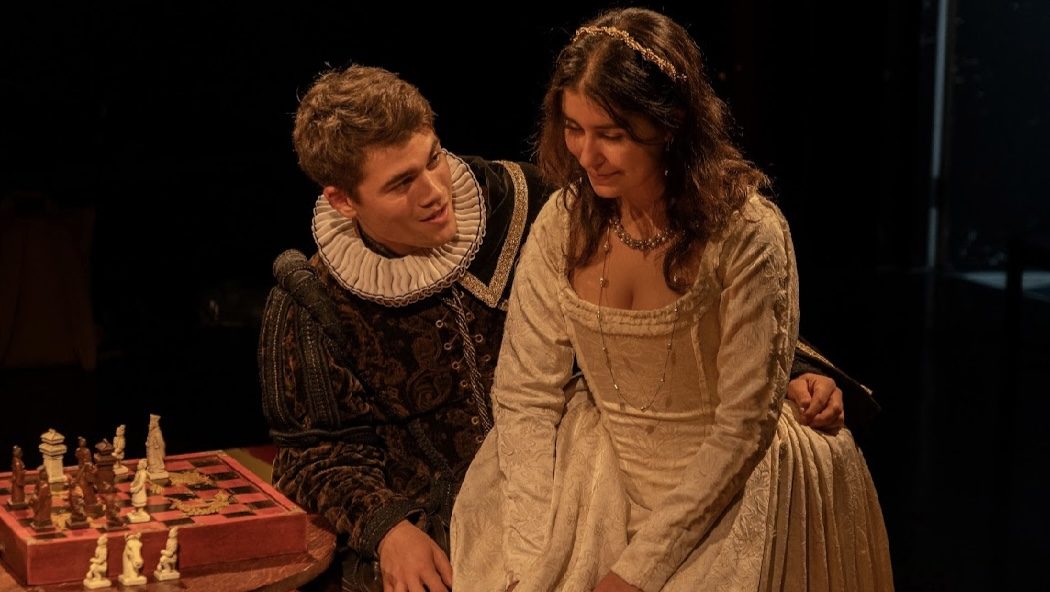I arrived at a rehearsal of Women Beware Women and found Hippolito (Kit Parsons) and Isabella (Céline Mathilda), uncle and niece, embracing and sharing an incestous kiss flavoured by the punnet of grapes sat between them. “‘Tis beyond sorcery, this, drugs or love-powders; / Some art that has no name”, Hippolito lamented centre-stage. This was an introduction fitting for a play whose driving force, as director Jem Hunter put it, is “sex”.
Thomas Middleton’s infamous revenge tragedy Women Beware Women (1657) follows a series of affairs in an increasingly debauched Florentine court, which culminate in a massacre at a masque. Curious to see how this depravity was taking shape, I interviewed the cast and their director three days before the show’s opening at the Pilch.
In a short interview with Jem, I tried to unpick some of the ideas that were animating the production. My first question was about the set: a garish chessboard lit impressionistically and peopled with costumes hired from the Royal Shakespeare Company. Jem was clear that this beauty was superficial, providing “a glimmering surface for the play, with…ribbons and everything and gorgeous costumes, and underneath it you will understand that there’s a very disgusting, sordid underbelly of lust that’s trying to get through the whole time”. This was the first hint of a theme that kept coming up in our conversation, that of artifice. Jem also described the period costumes in terms of their restrictive nature: “even physically it will restrain the actors”.
Like the set, the costuming is only another layer of restrictive beauty. Language, even the language of the play, then receives short shrift as another illusory attempt to capture what is physical: “the body is an instrument that makes noises, and the skin stretches over your ribcage and your diaphragm does stuff and your vocal chords vibrate, and you get a raw physical sense of language.” For Jem, the set, costumes, and even the words of the play are only an artificial layer papering over deeper forces.
These ideas have their place within a historical critique of theatre, uniting with Antonin Artaud (French practitioner of the Theatre of Cruelty which emphasised the physical at the expense of the rational) against ‘high realism’ with a sense that “you are trying to represent reality but you need to depart from reality and from that place of departure find the truth”. Jem described conventional realist concepts such as character and emotion as irrelevant, as ways of avoiding an address to those aspects of human experience that are “so much stranger than we think”. Instead, we should “uncover these strange spirits…something magical”. Those spirits seem to exist, for Jem, outside of language or character, instead residing in the scenario of the theatre and the movement of bodies as something strange and ritualistic.
I was curious to see how these ideas were actually finding expression in relationships between the people involved. My first question to the cast, about how they were conceiving of character in a more conventional sense, was met with opposition. Céline was clear that the play is “so representational, because it is a human chess game. It’s almost like meta-theatre”. The cast described the characters as mere puppets within a larger structure, each assigned a chess piece, each acting out of their own control. It was clear that direction in terms of psychological states had been rejected throughout the rehearsal process, replaced with non-naturalistic blocking and an emphasis on spectacle.
When I asked Jem about how he found working with the cast, he stated that: “I think the main problem with them was coming to terms with, you don’t have to look normal on stage [sic]. You don’t have to act as if this is a conversation happening in a bedroom or something. It is a stage, and you are performing.” The cast seemed to share a sense of what the play is about and what the production was moving towards. I didn’t stay for long enough to get a sense of how this consensus had actually formed, but I did get a glimpse in Jem’s insistence that: “I constantly remind them of the chess pieces. I tell them, embody that. Chess pieces move in a very constrained way, and I think that’s the kind of deliberateness I want.”
As I left, I got the sense that the production was committed to a unifying idea, and that Middleton’s tragedy would probably be receptive. A text so immoral, self-conscious, and garish can only be approached through extremes. Whatever is behind these characters – lust, fate, God, or theatre – we will certainly see a damned humanity spread spectacularly across the stage. This is a production where violence and immorality will be celebrated as the basis of a new understanding, of a place beyond ourselves. What this place looks like is up to the cast and crew on Wednesday.
You can watch Women Beware Women at the Michael Pilch Studio from the 5th to 8th of November.


